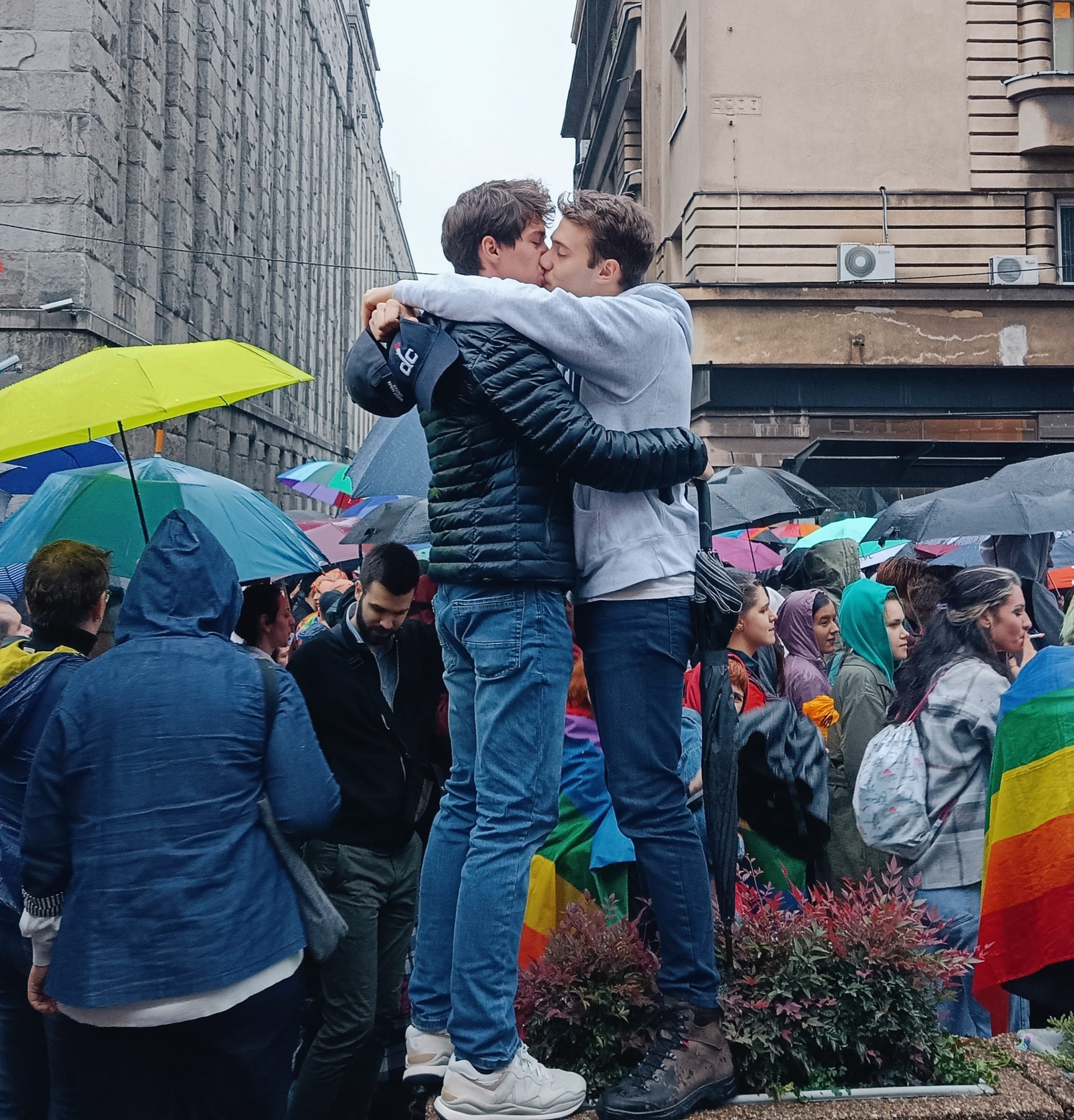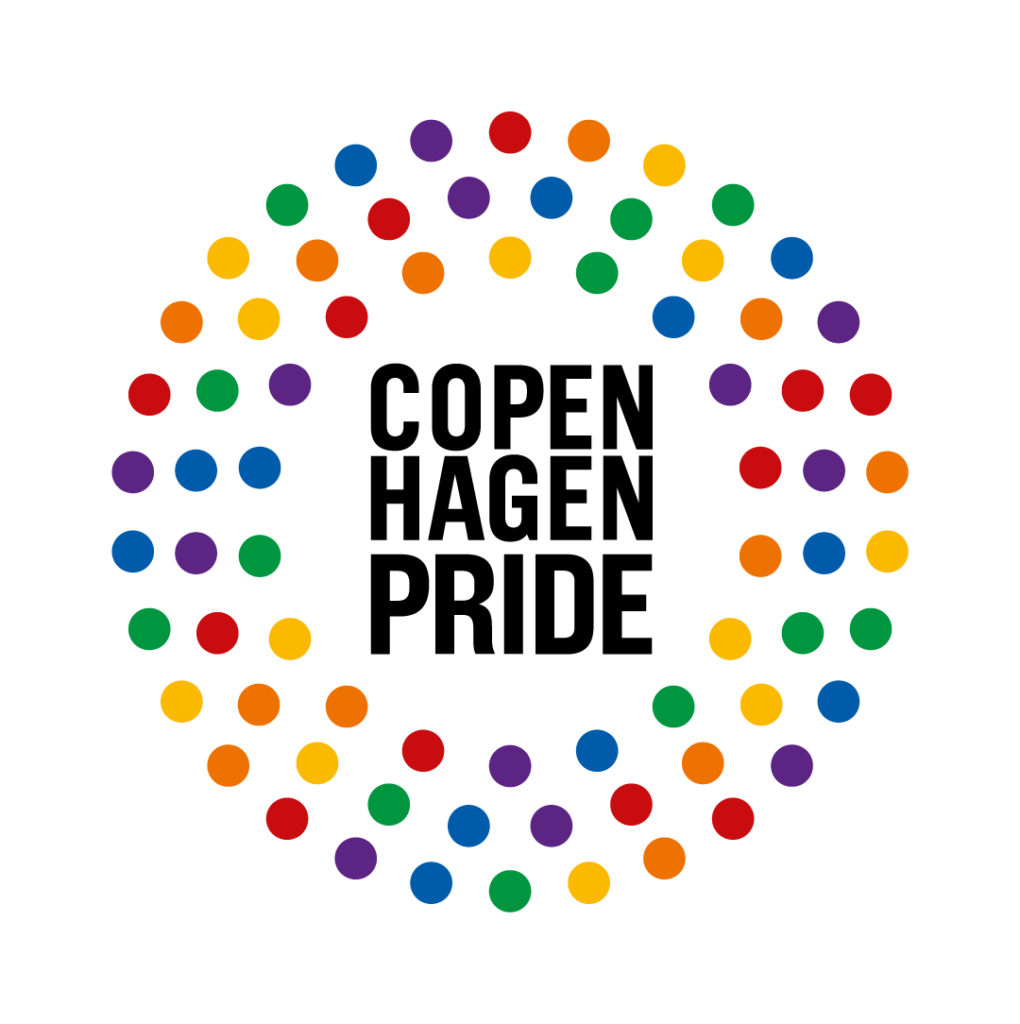
EuroPride in Belgrade
“Šetali smo, šetamo i šetaćemo”
“We walked, we walk and we will walk”
By Mariya Alfa Staugaard
Photos: Vesna Lalić
The rain is pouring down.
Around us, people are standing close together, most of them under umbrellas or wearing plastic rain ponchos. Most of the rainbow flags are as drenched as we are – but they are being waved nonetheless. Right in front of us is the biggest rainbow flag laid out on the ground, temporarily turned into a dance floor before it is going to be lifted up and carried as part of the march. The march that, until this morning, was banned by the government. The march that has been fenced in by police to keep counter protesters at bay. We’re in Belgrade, the capital of Serbia, and the first EuroPride march in the Western Balkan region is about to begin.
Rewind to two days ago, 15 September. I’m traveling with my Copenhagen Pride colleague Simone and we’ve just arrived at the airport with plenty of time to spare. We’re catching the few rare rays of autumn sunshine outside the departure gate before heading in. The last few days have been full of concerning news about counter protests, safety measures, and a lack of political will to guarantee the safety of Pride participants. It’s at the forefront of our minds, too.
“I feel pretty secure, overall. But now that we’re sitting here, getting ready to go, I’m thinking about it more,” Simone says. “But I do feel safe going.”
“I’ve been feeling scared,” I reply. “I don’t find that very flattering to admit, but I have. However, I can feel how important it is to me that we go.”
“It’s so important that this event goes ahead. It seems crucial that many of us show up and show our solidarity,” Simone agrees.

The rocky road to EuroPride
Even before the latest developments, Belgrade’s road to EuroPride had not been easy. In the last edition of HeartCore, another one of our writers had a talk with Marko Mihailović, director of Belgrade Pride. He laid out how the history of Pride in Serbia has long been tainted by violence and protests, fuelled by the unlikely union of the Serbian Orthodox Church and football hooligans. When Marko and his colleagues made the bid for EuroPride in 2019, they were asking for the opportunity to make history. Their slogan for the event summarized: It’s time.
When Marko and his colleagues made the bid for EuroPride in 2019, they were asking for the opportunity to make history.
The bid was won and the planning began. However, not everyone supported Belgrade Pride’s vision for a peaceful and tolerant demonstration of the progress made by the country since its first Pride in 2001 that ended in a harrowing display of violence. Far-right and religious fundamentalist groups organized anti Pride protests in August and September 2022, with the largest one drawing thousands of participants. The authorities saw this and saw an excuse to shut down the event.
In late August, the President of Serbia Aleksandar Vučić called for the cancellation of the event at a press conference. What followed was an impressive mobilization of the global and local LGBTI+ community which resulted in 27,000 signatures being handed over to the government from people who wanted to say loud and clear: You are not going to silence us.

United we stand – proudly we march
And so it was that on the morning of the march, organizers got the final go-ahead along with a promise from Serbian Prime Minister Ana Brnabić that no one would get hurt.
And that brings us to the rainy square next to the National Assembly of Serbia, where Simone and I are standing with thousands of other activists, diplomats, politicians, and LGBTI+ persons – Serbian as well as international. We have been standing here for over an hour as police are spread all over the city, trying to contain the counter protesters that are trying to get near us. In about 30 minutes, we’re going to learn about the stun grenades they are hurling at the police in order to do so.
It takes a while, but then the signal is given – and we walk. Led by a small truck blasting Pride classics by the likes of Lady Gaga and Britney Spears, we move at the familiar slow pace of a tightly packed parade. Simone and I look like typical Scandinavians with our black umbrella and rain poncho, but we’ve been given rainbow flags and they spruce up our looks. In the buildings around us, some people are waving from their windows. Others have put up rainbow flags. The streets are lined by police officers, stone-faced and sporting riot shields. Among us walk employees of the private security firm hired by the organizers. The mood is exhilarating, mixed with an undercurrent of nervous anticipation as we learn about the riots taking place around the city.
After walking around 600 meters, we arrive at Tasmajdan Stadium, where the closing concert is about to begin. On the way, we passed St. Mark’s Orthodox Church, where religious anti LGBTI+ protesters were waving signs and banners as the bell rang furiously. Simone, along with many others, waved back at them with rainbow flags.
I am tired after the march, and Simone and I share a laugh about how our joints are sore after standing up for several hours. It makes us feel old. We both want to head towards the hotel, but we have been advised to wait until we get confirmation that it is safe – the riots are still ongoing and we are more vulnerable away from the group. And so we wait, as the sky gets darker and the rain heavier. When we do get the go-ahead, we walk briskly back to the hotel, saying little. This is probably the most unsafe we felt for the entire trip. Away from the safety of the large group of LGBTI+ people and supporters, we feel exposed. We later learn that a group of activists were attacked as they left the venue – reportedly while police stood by.

Where to now?
Back in our hotel room, we change into dry clothes and try to think up a way to get our shoes less soggy before the trip home tomorrow. We share a sense of having been part of something important. And regardless of the severe nature of the threats against the parade, I can’t help but feel such joy about how the spirit of celebration persevered. I’m in awe of anyone who’s ready to dance in the rain while surrounded by police in riot gear.
The next day, while we’re heading to the airport, I speak with several Danish news media outlets. They seem keen to get me to talk about the danger of the situation – the volatility. More than once, I get the question, “it’s so different from Pride in Copenhagen, isn’t it?”. And it was. I think back to my anxiousness before we left Copenhagen and how easy it would be to lean into the narrative of having survived a dangerous expedition. But I hesitate. Not because the severity of the situation should be underestimated; people were hurt and more yet could have been. Nor because we should speak of Serbia as a progressive haven – that would be far from the truth. But because I want to tell a story that isn’t about fear, but about perseverance. About the strength of the Serbian LGBTI+ community and the importance of international solidarity. I don’t want the bullies to define this event – I want our conversation about it to be transformative, to encourage support rather than despair. And when I look back, I want to think about dancing in the rain.
Acknowledgements: Fábio Carapinha, Jax Jakshøj, Milena Kočić, Patrick van der Pas, Steve Taylor and Stijn Hoevenaar from the Copenhagen 2021 and Copenhagen Pride team, who traveled Belgrade to show their support. Special thanks to the entire Belgrade Pride team for all their work and to EPOA for their support of international visitors.
INFO:
EuroPride Belgrade – hosted by local organization Belgrade Pride – ran from Monday 12 September when the rainbow flag was raised at the Palace of Serbia. More than 120 events took place throughout the week, culminating in the EuroPride March on Saturday 17 September followed by a closing concert. An estimated 7,000 people took part in the EuroPride March.
Source: European Pride Organisers Association




